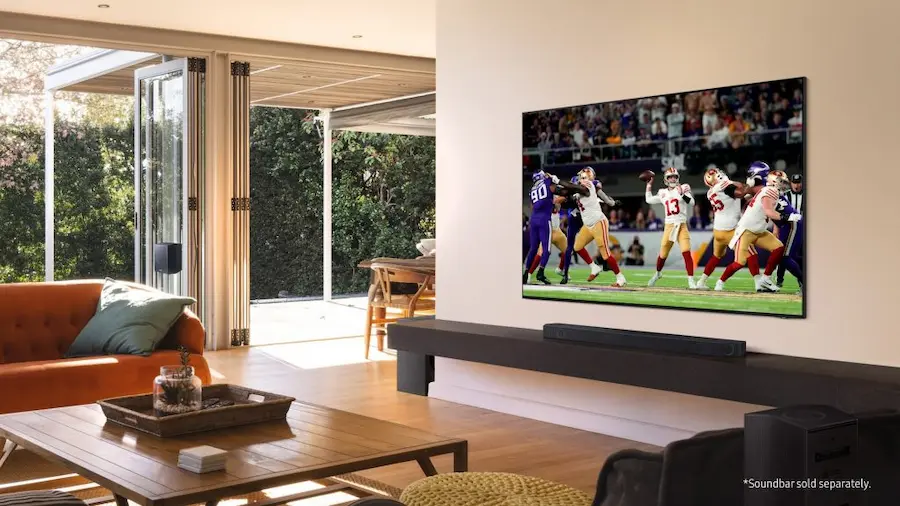Dont remember the exact model of your Samsung TV and need a quick hint to buy a mount, upgrade an antenna or check compatibilities like HDMI 2.1? Good news: that information is not only at hand, it also lets you decipher the year, panel type, sales region and even the tuner. Here we explain where to find the model number and how to interpret it like a true living-room hacker. Remember that recently Samsung made a tutorial with tips to choose the TV that best suits you.
Where to see the model number: rear label and TV menu
The most direct way is to look at the identification label located on the back of the TV. There you will find the model number accompanied by a barcode and other essential data. Samsung places this sticker on all its televisions and also on other brand devices such as soundbars, home theater systems, Blu-ray players or even MP3/MP4 players, so the habit of “checking the back” always pays off.
If your TV is a Smart TV, you have an even more convenient alternative from the system itself: go to Settings (gear icon) and look for the Support section. Inside, open About This TV. On that screen you will see the model code, the serial number and even the installed software version. On some models you may need to expand “All settings” to see the full menu. Keep in mind that this path is only available on smart TVs; non-connected models do not include this option.
With either method you’ll have the full model code. Now what? It’s time to decipher it to squeeze all the information it hides.
Models from 2008 onwards: what each letter and number means
In recent models, the first character indicates the type of TV:
- Q = QLED
- U = LED
- P = Plasma
- L = LCD
- H = DLP
- K = OLED
The second character indicates the main sales region:
- N = North America
- E = Europe
- A = Asia
Next comes the screen size in inches. For example, “62” equals a 62-inch diagonal. After that comes a sequence that identifies the family or series, and this is where very recognizable ranges become visible. Some useful patterns:
- LS03C / LS03B / LS03A: The Frame (2023 / 2022 / 2021)
- LS05T: The Sero (2020)
- LS01T: The Serif (2020)
- LST7T: The Terrace (2020)
- QN***C / QN***B / QN***A: Neo QLED 8K (2023 / 2022 / 2021)
- Q**B / Q**A: QLED 4K (2022 / 2021)
- Q***T: QLED 8K (2020)
- RU (2019 UHD), TU (2020 UHD), AU (2021 UHD): UHD families by year

After that appears a letter that indicates the “generation” within the range (A = first, B = second) and another that defines the built-in tuner, a key detail if you plan to use an antenna or cable TV:
- F = ATSC/QAM (US, Canada)
- U = DVB (Europe)
- G = ISDB-T (Latin America)
The next letter is usually the design code (commonly X), and the final block of two letters reveals the country or region. The most common are: ZA (US), RU (Russia), UA (Ukraine), ZC (Chile), XU (Europe/UK) and XY (Australia). In fact, with this breakdown you can know in seconds whether your TV comes from the European or American market, useful when looking for updates, spare parts or when comparing specifications between regions.
In short: with the first pair of letters you’ll know the type and region; with the numbers, the size; with the family, the positioning (The Frame, Neo QLED, etc.); with the generation letter and the tuner, the “fine print” that will determine compatibilities and experiences.
Models 2007 and earlier: reading the prefix, year and resolution
In older TVs the scheme changes, but the logic remains clear. The model prefix identifies the technology type:
- FP / HP = Plasma
- LN = LCD
- HL = DLP
- TX = CRT
After a dash, the first letter indicates the model year: T (2007), S (2006), R (2005), P (2004), N (2003) and M (2002). Then you will see numbers that indicate the diagonal in inches, followed by other digits that mark the specific series. The next block summarizes the resolution: F means Full HD and H indicates high definition.
As in newer models, an X usually appears as a design code and, at the end, a group of letters intended for manufacturing information. This standard allows you to quickly place the technological context of the era: knowing whether you’re facing an HD or Full HD panel, the exact year, and the image platform, something essential if you’re looking for peripherals, cables or mounts appropriate for that generation.
With this map in mind, doesn’t the model number look less like a hieroglyph now? It’s a super useful identifier to find out the TV’s age, panel type, region and tuner, and it will also help when contacting support or comparing ranges. Next time someone asks you which Samsung you have, you’ll be able to answer with pinpoint accuracy, just like when you check your router’s firmware version before updating.
.


